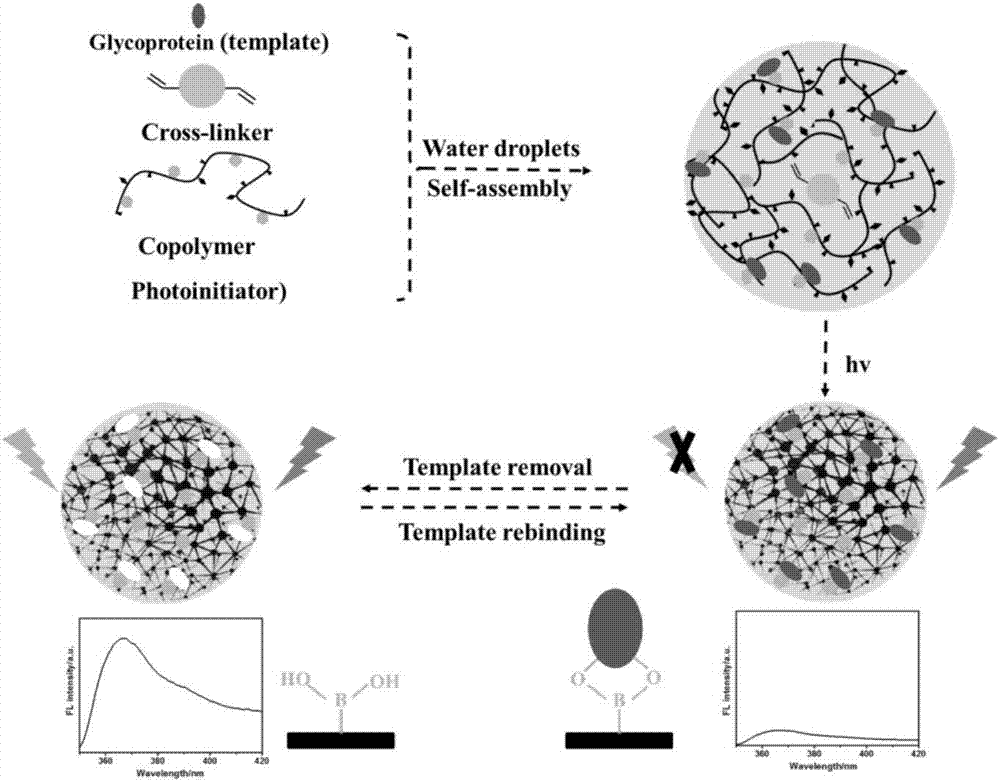Method for preparing glycoprotein imprinting fluorescent nanoparticles based on macromolecule self-assembling
A technology of fluorescent nanometer and glycoprotein, which is applied in the direction of fluorescence/phosphorescence, analytical materials, measuring devices, etc., can solve the problems of poor selectivity and achieve good selectivity, fast adsorption speed, and environmental friendliness
- Summary
- Abstract
- Description
- Claims
- Application Information
AI Technical Summary
Problems solved by technology
Method used
Image
Examples
Example Embodiment
[0019] Example 1
[0020] The first step: the monomer acrylic acid (0.3603g, 5mmol), vinyl carbazole (0.9663g, 5mmol), vinylbenzene boronic acid (0.0015g, 0.01mmol) azobisisobutyl cyanide (0.0328g, 2% mt %) into a 50ml round-bottomed flask, add 15mL solvent N,N-dimethylformamide (DMF), pass N 2 After removing the oxygen in the solution for 20 minutes, under stirring, the temperature was kept at 80°C and reacted in an oil bath for 24 hours. The monomers ethylene glycol methacrylate (0.711g, 5mmol) and triphenylphosphine (0.0262g, 0.1mmol) and hydroquinone (0.0028g, 0.025mmol) were dissolved in 5mL DMF and added dropwise to the above polymer solution through a constant pressure dropping funnel. Under stirring, the temperature was kept at 95℃. React in a bath for 12 hours, precipitate with petroleum ether three times, and dry overnight at 40°C in a vacuum oven to obtain a photocrosslinkable amphiphilic random copolymer containing phenylboronic acid;
[0021] Step 2: Dissolve 10mg of...
Example Embodiment
[0023] Example 2
[0024] The first step: the monomer acrylic acid (0.3603g, 5mmol), vinyl carbazole (0.9663g, 5mmol), vinylbenzene boronic acid (0.0015g, 0.01mmol) azobisisobutyl cyanide (0.0328g, 2% mt %) into a 50ml round-bottomed flask, add 15mL solvent N,N-dimethylformamide (DMF), pass N 2 After removing the oxygen in the solution for 20 minutes, under stirring, the temperature was kept at 80 ℃ and reacted in an oil bath for 24 hours. The monomer ethylene glycol methacrylate (0.355g, 2.5mmol), triphenylphosphine (0.0262g) , 0.1mmol) and hydroquinone (0.0028g, 0.025mmol) were dissolved in 5mL DMF, and added dropwise to the above polymer solution through a constant pressure dropping funnel. Under stirring, the temperature was kept at 95℃. React in an oil bath for 12 hours, precipitate with petroleum ether three times, and dry overnight at 40°C in a vacuum oven to obtain a photocrosslinkable amphiphilic random copolymer containing phenylboronic acid;
[0025] Step 2: Dissolve 1...
Example Embodiment
[0027] Example 3
[0028] The first step: the monomer acrylic acid (0.3603g, 5mmol), vinyl carbazole (0.9663g, 5mmol), vinylbenzene boronic acid (0.0015g, 0.01mmol) azobisisobutyl cyanide (0.0328g, 2% mt %) into a 50ml round-bottomed flask, add 15mL solvent N,N-dimethylformamide (DMF), pass N 2 After removing the oxygen in the solution for 20 minutes, under stirring, the temperature was kept at 80°C and reacted in an oil bath for 24 hours. The monomers ethylene glycol methacrylate (0.711g, 5mmol) and triphenylphosphine (0.0262g, 0.1mmol) and hydroquinone (0.0028g, 0.025mmol) were dissolved in 5mL DMF and added dropwise to the above polymer solution through a constant pressure dropping funnel. Under stirring, the temperature was kept at 95℃. React in a bath for 12 hours, precipitate with petroleum ether three times, and dry overnight at 40°C in a vacuum oven to obtain a photocrosslinkable amphiphilic random copolymer containing phenylboronic acid;
[0029] Step 2: Dissolve 8mg of ...
PUM
 Login to view more
Login to view more Abstract
Description
Claims
Application Information
 Login to view more
Login to view more - R&D Engineer
- R&D Manager
- IP Professional
- Industry Leading Data Capabilities
- Powerful AI technology
- Patent DNA Extraction
Browse by: Latest US Patents, China's latest patents, Technical Efficacy Thesaurus, Application Domain, Technology Topic.
© 2024 PatSnap. All rights reserved.Legal|Privacy policy|Modern Slavery Act Transparency Statement|Sitemap

